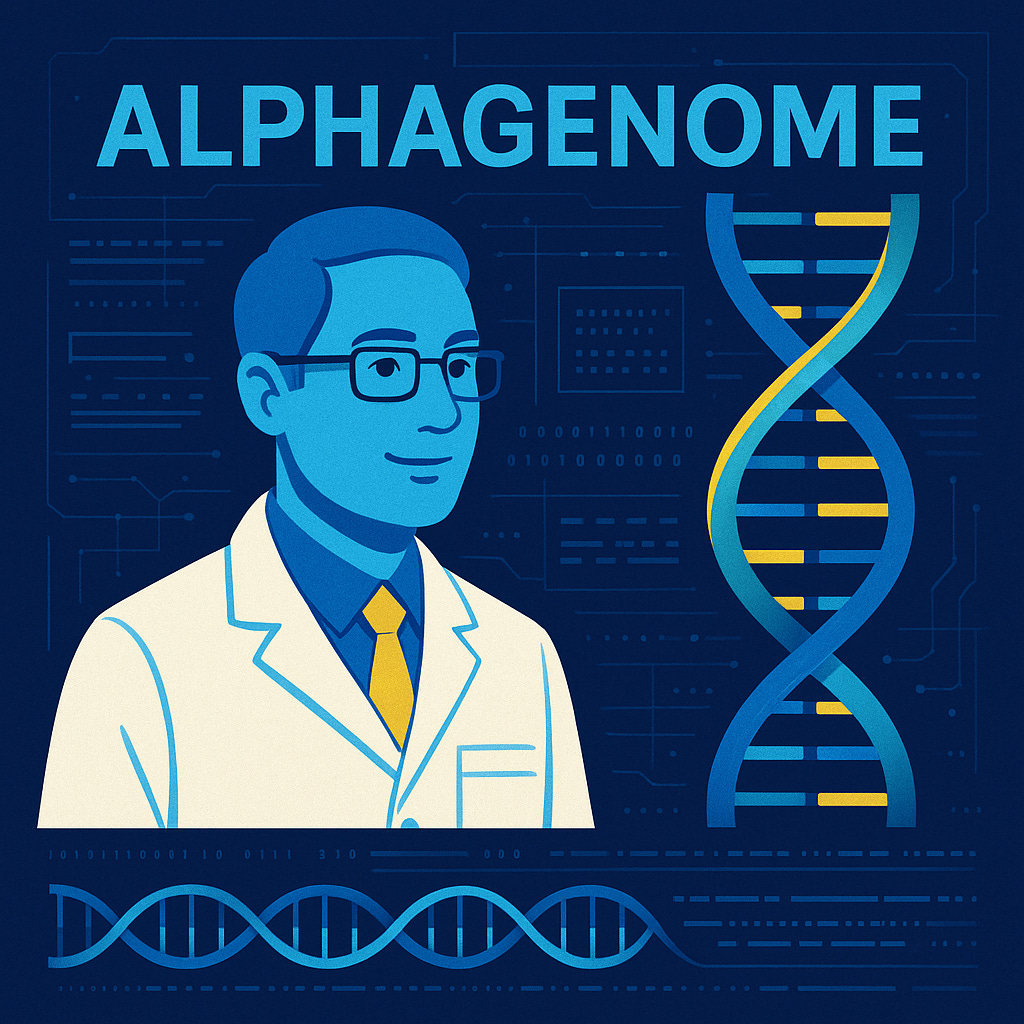TheSequence Radar #674: Transformers in the Genome: How AlphaGenome Reimagines AI-Driven Genomics
Was this email forwarded to you? Sign up here TheSequence Radar #674: Transformers in the Genome: How AlphaGenome Reimagines AI-Driven GenomicsA model that could advance the future genomics.Next Week in The Sequence:
Let’s Go! You can subscribe to The Sequence below:📝 Editorial: Transformers in the Genome: How AlphaGenome Reimagines AI-Driven GenomicsI have been obsessed with AI in genetics for some time so I couldn’t write about anything else today other than DeepMind’s new model: AlphaGenome! AlphaGenome merges some of the best -established techiques in AI-driven genomics such as large-scale sequence context with base-pair precision to chart the regulatory genome in a way never before possible. The model’s four-headed architecture digests up to one million contiguous base pairs in a single pass, outputting synchronized predictions for chromatin accessibility, transcription-factor occupancy, RNA expression, splicing, and 3D genome architecture. This unified approach replaces fragmented, single-modality pipelines—each requiring separate models and datasets—with one cohesive model that excels across tasks, streamlining variant effect analysis for researchers. At its core, AlphaGenome marries convolutional layers, which capture local nucleotide motifs analogous to transcription-factor binding sites, with transformer modules that integrate distal regulatory elements hundreds of kilobases apart. DeepMind’s design eschews downsampling, ensuring every nucleotide contributes to high-resolution inferences. As functional genomics datasets from consortia like ENCODE, GTEx, and 4D Nucleome expand, this backbone stands ready to unveil regulatory grammar buried deep in non-coding DNA. Traditional genomics models often excel at one signal—SpliceAI for splicing, ChromBPNet for chromatin state—necessitating an ensemble of tools to profile variant consequences fully. AlphaGenome’s simultaneous four-headed predictions eliminate this bottleneck, revealing cross-modal interactions—e.g., how a variant that disrupts a splice site may also alter local chromatin loops—opening novel avenues for mechanistic insight. In benchmark evaluations spanning 24 sequence-prediction and 26 variant-effect tasks, AlphaGenome matches or surpasses specialized baselines in over 90% of cases. It outperforms SpliceAI, ChromBPNet, and other state-of-the-art models by significant margins, all while completing variant-effect scans in under a second—transforming in silico hypothesis testing from minutes or hours to real-time speed. The genomics market in 2025 stands at an inflection point: cloud-based sequencing costs have halved over five years, single-cell and long-read technologies have become routine, and multi-omic datasets proliferate. Yet, analytical bottlenecks limit the translation of raw data into actionable insights. AlphaGenome arrives precisely when biotechnology and pharmaceutical companies demand scalable, AI-driven interpretation to bridge the gap from variant discovery to biological understanding. Its ability to standardize and accelerate regulatory variant annotation is poised to catalyze next-generation diagnostic tools, precision therapeutics, and synthetic biology platforms, redefining competitive advantage in a data-saturated market. DeepMind’s preview API grants non-commercial researchers early access to AlphaGenome, democratizing large-scale regulatory predictions. From pinpointing causal non-coding mutations in disease cohorts to engineering synthetic enhancers with bespoke cell-type specificity, this open sandbox invites collaborative breakthroughs across academia and industry. If AlphaFold decoded protein structures, AlphaGenome now deciphers the regulatory code—the “dark matter” governing gene expression. As single-cell, long-read, and cross-species datasets proliferate, the model’s extensible architecture promises seamless integration of new modalities. The future of genomics is computational, and AlphaGenome lights the path forward: an intellectual and technological leap toward understanding—and ultimately rewriting—the language of life. 🔎 AI ResearchAlphaGenome: advancing regulatory variant effect prediction with a unified DNA sequence modelAI Lab: Google DeepMind Confidential Inference Systems: Design Principles and Security RisksAI Lab: Pattern Labs / Anthropic USAD: Universal Speech and Audio Representation via DistillationAI Lab: MIT CSAIL UniVLA: Unified Vision-Language-Action ModelAI Lab: CASIA / BAAI / Tsinghua University / HKISI ProtoReasoning: Prototypes as the Foundation for Generalizable Reasoning in LLMsAI Lab: ByteDance Seed / Shanghai Jiao Tong University Reinforcement Learning Teachers of Test-Time ScalingAI Lab: Sakana AI 🤖 AI Tech ReleasesGemma 3nGoogle released a full version of Gemma 3n, its mobile optimized model. Gemini CLIGoogle open sourced Gemini CLI, a coding terminal agent powered by Gemini. Manus BrowserManus released an agentic browser. Qwen-VLoAlibaba open sourced Qwen-VLo, an image understanding and generation model. 🛠 AI in ProductionProject VendAnthropic showcased Project Vend, a system that allows Claude to run a small shop. Ray at PinterestPinterest shares how they scale end-to-end ML pipelines with Ray. 📡AI Radar
You’re on the free list for TheSequence Scope and TheSequence Chat. For the full experience, become a paying subscriber to TheSequence Edge. Trusted by thousands of subscribers from the leading AI labs and universities. |
Similar newsletters
There are other similar shared emails that you might be interested in:


